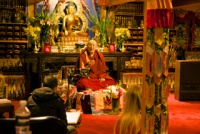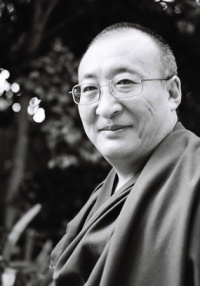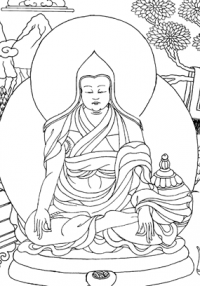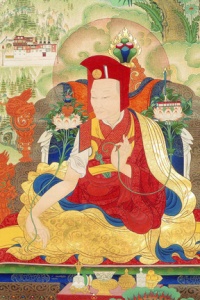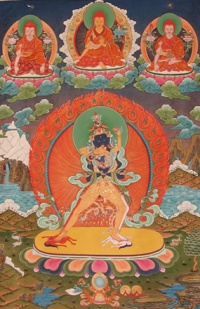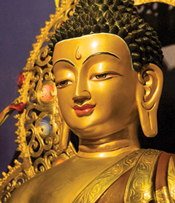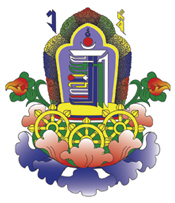Tibetan Buddhist Rime Institute
| Tibetan Buddhist Rime Institute | |
|---|---|
Tibetan Buddhist Rime Institute | |
| Information | |
| Tradition/Linage | Tibetan, Jonang Kalachakra lineage |
| Main School | Vajrayana |
| Founded | Founded(when)::2005 |
| Contact Infotmation | |
| Address | 1584 Burwood Hwy Belgrave Victoria 3160 Australia |
| Country | Australia |
| Coordinates | service=google }} {{#geocode:1584Burwood HwyBelgraveVictoriaAustralia|format=float|service=google}} service=google }}The "_geo" type of this property is invalid |
| Map | {{#display_map:{{#geocode:1584Burwood HwyBelgraveVictoriaAustralia}}|height=250px|width=250px|zoom=18}} |
| Phone | Phone::(03) 9754 6212 |
| Fax | Fa(03) 9754 6214::(03) 9754 6214 |
| Website | Website::http://rimebuddhism.com/ "Website" has not been listed as valid URI scheme. |
| Email::temple@rimebuddhism.comURIs of the form "Email::temple@rimebuddhism.com" are not allowed. | |
Tibetan Buddhist Rime Institute
The Tibetan Buddhist Rime Institute was founded by Khentrul Rinpoche in 2005. Rime means “non-sectarian” and is unusual within Buddhism. The Rime Institute offers profound and extensive teachings from all Tibetan Buddhist traditions, including Mahayana and Tantrayana, according to individual needs.
In addition, we specialise in the teachings of the Jonang tradition which includes the Shentong Madhyamaka view and the Kalachakra Six Yoga practice, which are very rare throughout the world and are said to have an important role to play in the future of Buddhism.
Our goal is to promote a non-sectarian view and harmony within all Buddhist traditions, and we also hope to develop programs to help people in the local and wider Australian community. We offer tours to Tibet to introduce people to an ancient culture and a vastly different way of life, along with a project to build a medical facility in Tibet. In the Tibetan Buddhist tradition, there is a particular emphasis on the importance of an authentic spiritual lineage, and therefore the aims of the Rime Institute are very closely connected the aspirations of Rinpoche’s root teacher, the great Lama Lobsang Tinley. Lama was one of the most exceptional and highly realised Buddhist masters of the last generation, and especially wished that the pure Kalachakra Tantra and the precious Amitabha Sutra teachings from his lineage be spread to the West.
Khentrul Rinpoche
Renowned Jonang scholar and Rime master, Khentrul Jamphel Lodrö Rinpoche, studied in 11 monasteries under 25 teachers before becoming Khenpo (teacher) of Dzamthang monastery in Tibet. He was awarded the title of Rimé master, meaning master of all traditions, by the supreme master Lama Lobsang Trinley in 1997 and conferred by His Holiness the Dalai Lama in 2003. His vast and comprehensive knowledge offers the West a rare opportunity to engage in Buddhist practice from a non-sectarian point of view and access the most profound teachings of Highest Yoga Tantra as taught by the Jonangpa. Khentrul Rinpoche is considered the 7th emanation of Bodhisattva Akasagarbha. His previous reincarnations appeared three times in Eastern Tibet as Washul Lhazu Lama, Trulku Ngawang and Getse Khentrul. Today, Khentrul Rinpoche is a highly realised Vajra Master of Kalachakra Tantra. He is known for his pure morality, incredible scholarship, meditative attainments and deep unwavering compassion. Rinpoche has written and published more than 10 books in Tibetan and other languages. He advises many monasteries and organisations.
Khentrul Rinpoche has two primary goals:
- To teach, share and practise non-sectarian Buddhist philosophy and meditation for ongoing spiritual investigation and development of the individual and broader community
- To inspire and encourage practitioners to engage in the most rare and precious Kalachakra Tantra teachings for the betterment of the world
Rinpoche’s Vision
The Tibetan Buddhist Rimé Institute was founded with the express purpose of supporting Khentrul Rinpoche in realising his vision for greater peace and harmony in this world. As our community continues to grow and develop, more and more people are getting involved with this extraordinary effort. To give you a sense of the scope of Rinpoche’s vision and to provide the community with a context for understanding our various activities, there are eight goals that reflect Rinpoche’s short and long term priorities:
Immediate Goals
Ultimately speaking, lasting, genuine happiness is only possible through profound personal transformation. Now more than ever, we need methods to develop our wisdom and actualise our greatest potential. It is for this reason that Rinpoche places such a heavy priority on the preservation of the Jonang Kalachakra Lineage. There are four ways in which Rinpoche proposes to do this:
Create opportunities to connect with an authentic and complete Kalachakra lineage in close collaboration with dedicated meditators in remote Tibet
Our goal is to create all of the supports for practicing Kalachakra in accordance with the authentic lineage masters who have upheld this tradition for thousands of years. We do this by commissioning statues and paintings, writing books and giving teachings around the world. We place particular emphasis on ensuring the authenticity of our materials, drawing on the profound experience of highly realised meditators who are dedicating their lives to these practices.
Establish international retreat centres for the study and practice of Kalachakra
In order to integrate the teachings into our minds, it is crucial to have the opportunity to engage in periods of intensive practice. Therefore, we are working to create the necessary infrastructure that will support and nurture the members of our community to engage in both short and long-term retreat. This includes the purchase of land and the construction of everything that is needed to conduct group and solitary retreats. Our long-term aim is to develop a network of such centres around the world, forming a global community that supports a wide variety of practitioners.
Translate and publish the unique and rare texts of Kalachakra masters
The Kalachakra System has been the subject of countless texts over the course of Tibet’s long history. So far, only a small fraction of these texts have been translated and made accessible in the West. While the theoretical texts are important, we aim to focus particularly on the pith instructions that will guide dedicated practitioners to a deeper experience of these profound teachings.
Develop the tools and programs for a structured learning experience
With pockets of students distributed throughout the world, we believe it is important to make the most of modern technologies to facilitate the process of learning for our students. Our aim is to develop a robust online educational platform that allows our international community to access quality study programs that are intuitive, structured and engaging.
Long-Term Goals
While we each work towards achieving ultimate peace and harmony in our own minds, we must not lose sight of the fact that we exist within the context of a world filled with a great diversity of individuals. These individuals give rise to a wide variety of beliefs and practices that in turn shape how we relate and interact with each other. In this interdependent reality, it is vital to find viable strategies for promoting greater tolerance and respect. To this end, Rinpoche proposes four specific areas of activity:
Promote the development of a Rimé Philosophy through dialogue with other traditions
With the desire to be constructive members of a pluralistic society, we need to learn ways of reconciling our differences. To this end, we aim to help people develop the positive qualities that promote an attitude of mutual respect, openness to new ideas and an inquisitive desire to overcome our ignorance.
Develop highly-realised role models by offering financial support to dedicated practitioners
In order to ensure the authenticity of our spiritual traditions, it is imperative that there are people who actualise the highest of realisations. Therefore, we aim to create a financial scholarship program which facilitates genuine practitioners who wish to dedicate their lives to spiritual development, regardless of their system of practice. By helping people actualise the teachings, they become positive role models for those around them, inspiring and guiding the generations to come.
Actualise the great potential of female practitioners by developing specialised training programs
The Tibetan culture has a long history of cultivating highly realised masters through the intensive training of those who are recognised to have great potential. Unfortunately, all too often the search for potential was focused only on male candidates. Rinpoche believes that it is increasingly important to have strong, highly realised, female role models who can help to bring greater balance into our world. For this reason, we are working to develop a unique training program for providing women with the opportunity to actualise their spiritual potential. It is our aim to design a specialised curriculum as well as the financial infrastructure to fully support all aspects of their education.
=Promote greater flexibility of mind and a broader understanding of reality through modern educational programs
In a world that is rapidly evolving, we need to rethink the types of skills that we are teaching our children. The rigid structures of the past are often ill equipped to prepare students for the challenges that they will face during their lives. Therefore, we aim to develop a variety of educational programs that can help children to become more flexible and more capable of adapting to their context. An important part of these programs is the development of greater awareness of the role that our mind plays in our day-to-day experiences. We also aim to bring reforms into the monastic education system that would help make them more relevant for this modern world.
Rimé Philosophy
Literally, ‘rimé’ means a ‘non-sectarian’ or ‘non-biased’ view. While some people may think this is related to the idea of all systems being equal, it is actually focused on recognising the value and benefit of multiple points-of-view.
One way to understand this is to consider how we use medicine. There are many medicines and each has the capacity to cure specific types of sicknesses. We do not normally mix our medicines. Instead, we recognise the specific needs of each patient and choose the right medicines for helping them overcome their problems.
In the same way, developing a Rimé philosophy means knowing how each system works, what are its defining characteristics, what are its strengths and how can it be used to alleviate dissatisfaction. While we may have a personally favourite view, a favourite practice or a favourite system, there is no contradiction. We can hold a non-sectarian view while recognising that specific practices and teachings are especially suited for our needs.
Developing the Rimé View
The Rimé view can be understood in variety of ways. At the most fundamental level, Rimé is expressed as a feeling of respect based on faith. This person may or may not know the specific reasons why they respect or believe in the different traditions. Instead she relies on a general sense for the common values that each tradition represents. This level of the Rimé view is often a result of cultural conditioning, positive influences and innate predispositions.
From this foundation of respect, individuals begin to develop a more active, inquisitive level of the Rimé view. This is characterised by an open-minded approach which longs to understand the distinguishing factors of different traditions. There is a sense of wanting to know more, to expand one’s understanding and perspective. It is a process of investigation where the individual actively probes and tests different ideas. In so doing, she resolves doubts and gains greater insight into the strengths and weaknesses of each tradition.
As the individual continues to develop her understanding, she begins to develop a sense of stability in her view. There is an inner resilience that allows her to face criticisms and biased arguments without losing their deeper perspective. She can see how each tradition relates to the others and how they can bring benefit to different types of people. At this level, the individual has developed an unshakeable and genuine respect for pluralistic traditions.
The Rimé Movement
The Rimé View is most often connected with the great masters of the 19th century Jamyang Khyentse Wangpo and Jamgön Kongtrul Lodrö Thaye. The movement that they popularised was however deeply rooted in the work of previous masters.
In the early 16th century, the great master Jonang Kunga Drolchok laid the foundations for the Rimé movement when he travelled extensively throughout many regions, gathering and practicing a wide variety of transmissions, empowerments and pith instructions. He collected these into his great work “The Hundred Teachings of Drolchok” (dolchok tridgya).
Then in the late 16th century, Kunga Drolchok’s reincarnation Kyabdak Drolway Gonpo (Jetsun Taranatha), continued his non-sectarian work by searching out and gathering the transmissions of many nearly extinct lineages. In particular, he placed particular emphasis in preserving the teachings of the Shangpa Kagyu, whose teachings survive to this day due to his efforts.
Khyentse Wangpo and Jamgön Kongtrul further expanded on this work by propagating the teachings widely and publishing many volumes of teachings and commentaries. Jamgön Kongtrul, who is believed to be the reincarnation of Taranatha, was responsible for authoring five treatises known as “The Five Treasuries”. These incredibly vast and comprehensive volumes present a wide range of the teachings, empowerments and rituals of the wisdom traditions developed in Tibet.
Why is it important to develop a Rimé philosophy?
The Rimé Institute strives to view all traditions with equal respect and to embrace the Rimé spirit, especially to help students new to Buddhism.
Traditionally, Tibetan Buddhist practitioners place a strong emphasis on the view and instructions passed on through their own lineages. This is crucial in maintaining authenticity of the teachings. Furthermore, many practitioners spend their entire lives in one monastery and devote much time and effort to a thorough training in one tradition, to the exclusion of others. As a result some practitioners are less open to the views and good qualities of other traditions.
The Rimé movement is critical to the advancement of Buddhism on a global scale as it teaches practitioners to respect all traditions, with the goal of creating a sound foundation of Dharma knowledge and practice. With this balanced view comes the ability to assist many people regardless of their beliefs. This is one of the main goals of Rimé and is recognised by many Tibetan masters as a rare and precious view of Buddhism.
In 2003, His Holiness the 14th Dalai Lama recognised Khentrul Rinpoche as a genuine Rimepa master, encouraging him to continue spreading this important movement.
Introduction to the Jonang tradition
While few outside academic circles have ever heard of the Jonang, it is not a new tradition. The Jonang trace their lineage back to India and the great Nalanda University. However, it did not become known by the name Jonang until its founder Kunpang Thukje Tsondru, settled in the Jomonang valley of Tibet during the 13th century.
One of the reasons that so few people are currently aware of the Jonang is due to the fact that they did not flee Tibet in 1959. So when the Tibetan Administration in Exile began registering traditions, the Jonang were absent. Therefore, very few foreigners were ever introduced to their authentic teachings.
It was not until 1990 that the first Jonang monks began to emerge from Tibet. Since then they have been requesting the Tibetan Administration to recognise their tradition as worthy of equal respect as the Nyingma, Kagyu, Sakya, Gelug and Bön traditions. While great advances have been made in respect to this, unfortunately this work is still not complete.
Why is the Jonang Tradition important?
Firstly, the Zhentong Madyamika philosophy is recognised as the highest view by many of the most realised Tibetan masters. The Jonang is the only one of the five major Tibetan Buddhist schools that emphasises this unique doctrine and upholds its lineage.
Secondly, the Kalachakra Tantra is the most comprehensive and effective system within Tibetan Buddhism. The Jonang is the only tradition that holds the entire Kalachakra system, including the unique completion practice known as the “Six Vajra Yogas”.
It is because the Jonang are the core holders of these two important lineages that it is crucial that the Jonang Dharma flourish. Failure to do so will result in the loss of these irreplaceable spiritual systems.
Study Programs
We offer Dharma classes for everyone. Our study programs include teachings for those new to Buddhism, people who have previously studied the Buddhist Path and those interested in advanced Buddhist teachings.
Drop-In Classes
Meditation and Yoga drop-in classes are perfect for those with a busy lifestyle. There is no need to book and no ongoing commitment. Each week the teacher delves into various aspects of meditation practice and its benefits.
Advanced Study Group
Advanced classes are broken into two study streams, Kalachakra Preliminaries and Zhentong Madhyamaka. Vajrayana is known as the Quick Path; it requires an unquestioning resolve to create the conditions for a better life and world.
